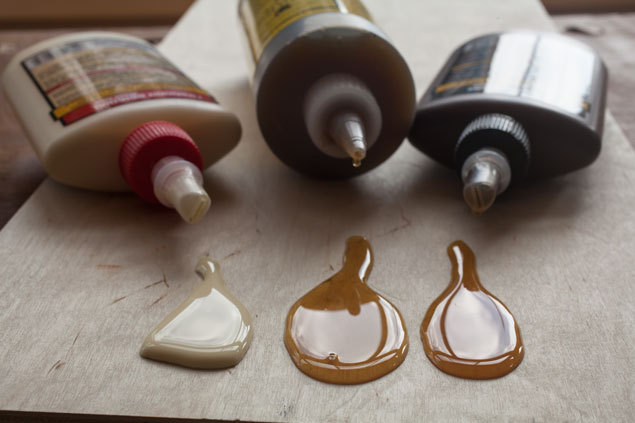We may receive a commission when you use our affiliate links. However, this does not impact our recommendations.
I’ve just finished writing an article on liquid hide hide glue for Popular Woodworking Magazine that takes a critical look at the adhesive compared to yellow glues. My hope is that it’s a fairly dogma-free article.
While liquid hide glue will probably always be my favorite adhesive for interior work, there are some cases where another glue is a better choice.
During the research for the article, I talked to adhesive scientists, glue makers and even visited Franklin International’s factory during the summer with a long list of questions. After getting some surprising answers, I put their assertions to the test in my shop.
I’m going to share some of the surprises here. For the rest, you’ll have to buy the magazine (sorry, editors have to eat, too).
Expiration Dates
One of the alleged downsides to liquid hide glue is that it expires after about a year in the bottle (though it can last 18 months or longer depending on how you store it or who is giving you the information).
But then the scientists at Franklin showed me some dried glue samples they had recently made with 10-year-old hide glue. The dried glue film was as hard as glass – just like you would see with a fresh bottle.
What gives? As Dale Zimmerman at Franklin explained, it’s all in how you store the glue. Heat and water are the enemies of liquid hide glue. So if you leave a bottle of glue open in your shed during the entire muggy summer (or in a hot car), you could ruin the glue before the expiration date.
But if you store the glue sealed up and in a cool basement, the life of the glue is greatly extended, as the tests at Franklin showed (which I repeated in my shop).
You don’t have to freeze it. You don’t have to store it in the fridge. In fact, Zimmerman cautioned that by storing it in a cooler the glue could take on water from condensation when you warm it up. Zimmerman’s advice: Just keep it sealed up in a cool basement.
Now some woodworkers would argue that glue is the cheapest part of any project, so why take a chance with old glue? It’s a good point, but think of it this way: If you store your liquid hide glue properly you don’t have to stress about the expiration date.
How do you test hide glue to see if it’s still good? That will be the subject of my next entry on this topic.
— Christopher Schwarz
Here are some supplies and tools we find essential in our everyday work around the shop. We may receive a commission from sales referred by our links; however, we have carefully selected these products for their usefulness and quality.










Hey Chris,
Would you let us know which month its going to be in? Looking forward to the complete article.
Thanks,
Jason
Way back in the mid-fifties, in my Jr. High woodworking shop, thew instructor heated glue in a pot before it could be used. I suspect that this was the traditional type of glue. Now we have liquid hide glue in a plastic squeeze bottle. What gives? There must be several types of hide glue available now.
I am sure you cover this and I am a subscriber but how about the hide glue you mix yourself – are there advantages and is it the best form to use with veneering if you do not want to deal with other glues?
So, for someone that’s never been in or seen a basement in his life, what temperature/humidity should we be shooting for?
(I did try and google for common/average values for a basement, but they seem to be +/- 30°f and +/- 50% humidity)
Something I learned the hard way about Liquid Hide is to not use it for putting in manufactured caning. Unlike a PVA white glue that shrinks up as it dries and helps to pull the caning tight, the liquid hide doesn’t have that property. Good thing it’s reversible though!